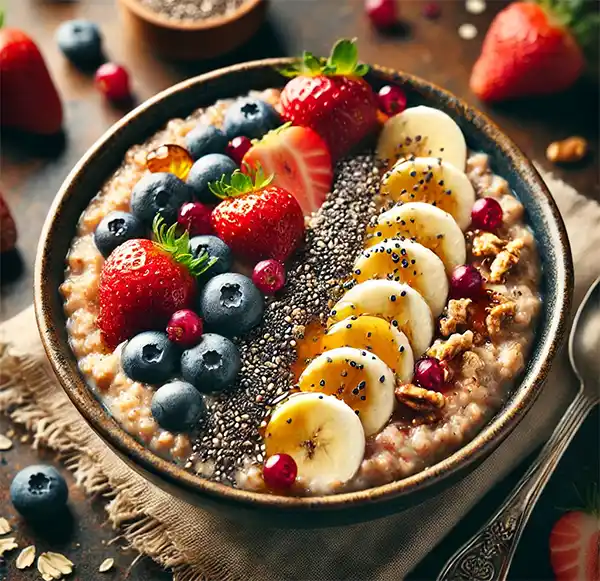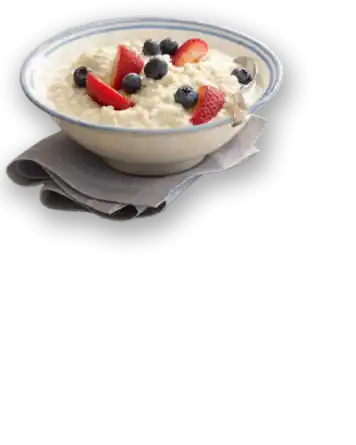Celebrating the Humble Oat
Every year on October 29th, we honor a breakfast staple that has seen us through cold mornings, diet plans, and health kicks: oatmeal. National Oatmeal Day is our chance to celebrate this warm, filling dish that, despite its simplicity, has managed to earn its place on breakfast tables around the world. Whether you’re a die-hard oatmeal fan or an occasional oat enthusiast, there’s no denying that oatmeal has become a beloved (if occasionally underrated) comfort food.
The Origins of Oatmeal
Long before oatmeal made its way into our breakfast bowls, oats were seen as a “lesser” grain compared to the likes of wheat and barley. In fact, oats were initially grown as animal feed, especially for horses and livestock, rather than as a staple human food. This hardy cereal grain was a natural fit for colder, harsher climates, thriving where other grains struggled to survive. It’s no wonder oats became especially popular in places like Scotland, where rugged weather and rolling hills made oat-growing the logical choice.
Early farmers might not have considered oats glamorous, but they were practical. People soon discovered that oats, when ground and cooked, could become a filling, nourishing dish. What oats lacked in glamour, they made up for in versatility and durability. Scottish Highlanders, for example, famously carried a sack of oats with them, mixing them with water to make “brose,” an early form of oatmeal that fueled them through long journeys and tough battles.
By the 17th century, oats became a breakfast staple in Scotland, where they were prepared as thick, hearty porridge, often seasoned with just a pinch of salt. This tradition of savory oatmeal persists in parts of Scotland to this day, much to the confusion of sugar-loving Americans. For Scots, oatmeal was more than just food; it was a cultural mainstay and a source of pride. They took their oats so seriously that they even developed dedicated porridge spurtles (wooden stirring sticks) to achieve the perfect consistency!
 The oat’s reputation as a food source spread slowly but surely, eventually making its way to North America with European settlers. By the 1800s, oats had earned a place on American breakfast tables, often paired with milk, honey, or a sprinkle of brown sugar. It was an economical choice, filling and packed with enough energy to fuel farmers through a full day’s work. But oats didn’t truly gain their "superfood" status until much later, when scientists began to uncover their impressive nutritional profile in the late 20th century.
The oat’s reputation as a food source spread slowly but surely, eventually making its way to North America with European settlers. By the 1800s, oats had earned a place on American breakfast tables, often paired with milk, honey, or a sprinkle of brown sugar. It was an economical choice, filling and packed with enough energy to fuel farmers through a full day’s work. But oats didn’t truly gain their "superfood" status until much later, when scientists began to uncover their impressive nutritional profile in the late 20th century.
From humble beginnings as horse feed to its current place on the superfood pedestal, oatmeal has certainly come a long way. And whether you’re cooking it thick and savory or with a swirl of maple syrup, every bowl carries a bit of history—one that began in the chilly highlands, with a grain that could withstand the elements and fuel generations.
Why Oatmeal Deserves the Hype
Oatmeal didn’t always enjoy its current superfood status. For a long time, it was known as the "cheap" breakfast, a sort of culinary wallflower. But modern science came to the rescue, revealing that oats are packed with nutrients like fiber, protein, iron, and magnesium, along with antioxidants known to support heart health. Suddenly, oatmeal went from being a bland breakfast option to a powerhouse in the health food world.
And that’s not all! Oatmeal is particularly famous for containing beta-glucan, a type of soluble fiber that helps reduce cholesterol levels. Eating a bowl of oatmeal every morning could make a difference not only for your taste buds but also for your heart. And who doesn’t love a food that’s delicious and good for you? Even if oatmeal might sometimes resemble wallpaper paste, it’s a paste with purpose.
Smooth or Textured?
Like any dish with a longstanding history, oatmeal has its controversies. There are two main camps: those who prefer creamy, smooth oatmeal and those who believe that oats should retain some chew. The first group tends to favor instant oats, which cook up quickly and have a soft, smooth texture. Meanwhile, the textured oat fans gravitate toward steel-cut oats, which take longer to cook but deliver a nutty flavor and a pleasantly chewy bite.
Then there’s the whole milk vs. water debate. Purists insist that water is the only true way to cook oatmeal. They’ll tell you that milk makes it too rich and takes away from the oats’ natural flavors. But milk lovers argue that dairy elevates oatmeal to a creamy delight. And don’t even get started on toppings. Some folks believe in a minimalist approach, with a dash of salt and a pat of butter, while others treat their oatmeal like a blank canvas, piling on fruits, nuts, spices, and sweeteners.
Whatever side of the oatmeal spectrum you fall on, there’s a version out there for you. The beauty of oatmeal is that it can be customized endlessly, fitting into both minimalist and maximalist philosophies with ease.
 Fun Ways to Dress Up Your Oats
Fun Ways to Dress Up Your Oats
While classic oatmeal is wonderful on its own, there’s a whole world of ways to take it to the next level. Imagine oatmeal topped with a swirl of peanut butter and banana slices, or cooked with a sprinkle of cinnamon and topped with caramelized apples. For those who like a little more adventure, try savory oatmeal with toppings like fried eggs, sautéed spinach, and a sprinkle of cheese—trust me, it’s better than it sounds!
For those who are on the go, overnight oats have taken the breakfast world by storm. All you need is a jar, some oats, your choice of milk, and any add-ins you desire. Pop it in the fridge overnight, and you have a ready-made, cold oatmeal breakfast the next morning. It’s the breakfast version of “set it and forget it.”
Or if you’re feeling nostalgic, you can even make oatmeal cookies. Sure, they’re technically a dessert, but if there are oats in them, they must be healthy, right?
Oatmeal Around the World
Oatmeal might seem like a Western phenomenon, but versions of this wholesome dish appear across the globe. In Scotland, oatmeal is known as “porridge” and often cooked with salt rather than sugar. In Nordic countries, it’s called “gröt” or “gröød,” and it’s often served with berries or lingonberry jam.
In Asian countries, rice porridge is more common, but oatmeal is making inroads thanks to its health benefits. In India, oats are sometimes added to savory dishes with spices, creating a unique twist that’s far from the sweet, cinnamon-heavy oatmeal found in American kitchens. And then there’s Mexico, where “avena” (oatmeal) is sometimes cooked with cinnamon and milk, resulting in a creamy, mildly spiced dish perfect for chilly mornings.
Despite its humble roots, oatmeal has managed to stand the test of time and emerge as one of the most versatile foods on our tables. It’s survived the carb-phobia of the early 2000s, the gluten-free craze (oats are naturally gluten-free but can be contaminated in processing), and even the rise of fancier breakfast options like avocado toast and acai bowls. There’s something about oatmeal that just feels reliable—it’s like the culinary equivalent of a warm hug.
And while fads will come and go, oatmeal’s staying power lies in its adaptability. Whether it’s a quick bowl of instant oats or a labor-of-love pot of steel-cut oats simmered for an hour, oatmeal delivers a satisfying meal that doesn’t need bells and whistles to be delicious (though bells and whistles, in the form of chocolate chips, never hurt).
How to Celebrate National Oatmeal Day
On National Oatmeal Day, let’s give a little extra love to our oats. Maybe it’s time to experiment with a new topping, try a savory oat recipe, or dive into the world of overnight oats if you haven’t yet. Or, if you’re feeling adventurous, go all out with an oatmeal bar, where everyone gets to customize their own bowl with toppings galore.
Consider sharing your oat creations online—if there’s one thing the Internet loves, it’s food pics. Tag your creation with #NationalOatmealDay and let the world see just how creative oatmeal can be.
And if you’re in the mood for a little culinary nostalgia, look up some old-school oatmeal ads. Back in the day, oatmeal was advertised as a miracle food that would make kids grow big and strong. While that might have been a bit of a stretch, there’s no doubt that oats pack a punch when it comes to nutrition.
National Oatmeal Day is a chance to appreciate this simple yet satisfying dish that has fed millions over the centuries. Whether you like it creamy, chewy, sweet, or savory, oatmeal is a versatile, nourishing meal that never goes out of style. So, this October 29th, lift your spoon in honor of the mighty oat, and remember: sometimes, the simplest foods bring the greatest joy.
Please Share our Content






 The oat’s reputation as a food source spread slowly but surely, eventually making its way to North America with European settlers. By the 1800s, oats had earned a place on American breakfast tables, often paired with milk, honey, or a sprinkle of brown sugar. It was an economical choice, filling and packed with enough energy to fuel farmers through a full day’s work. But oats didn’t truly gain their "superfood" status until much later, when scientists began to uncover their impressive nutritional profile in the late 20th century.
The oat’s reputation as a food source spread slowly but surely, eventually making its way to North America with European settlers. By the 1800s, oats had earned a place on American breakfast tables, often paired with milk, honey, or a sprinkle of brown sugar. It was an economical choice, filling and packed with enough energy to fuel farmers through a full day’s work. But oats didn’t truly gain their "superfood" status until much later, when scientists began to uncover their impressive nutritional profile in the late 20th century. Fun Ways to Dress Up Your Oats
Fun Ways to Dress Up Your Oats








 "Sláinte!" is a traditional Irish expression used as a toast, equivalent to "Cheers!" in English.
"Sláinte!" is a traditional Irish expression used as a toast, equivalent to "Cheers!" in English.